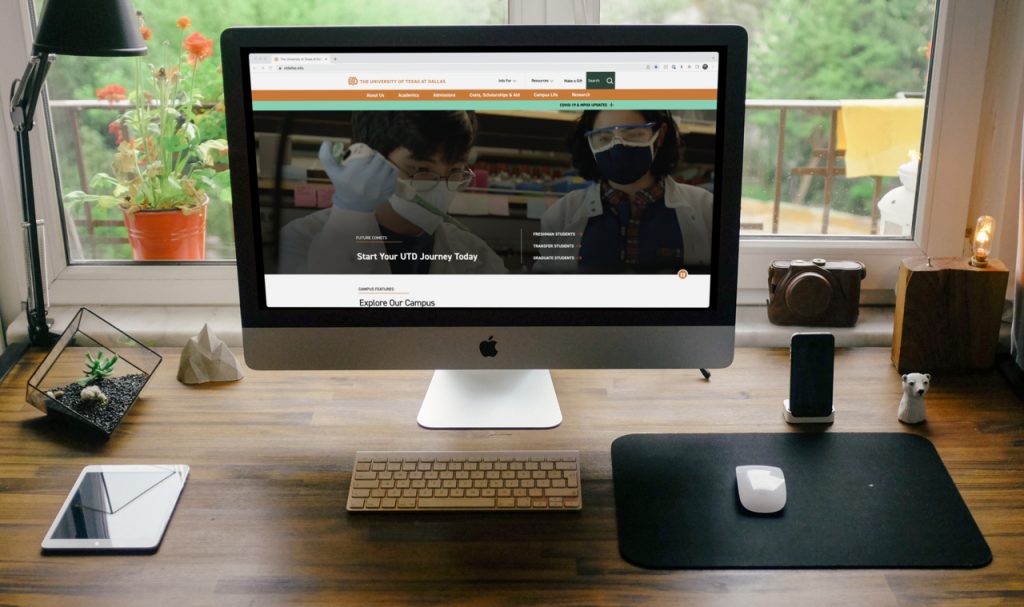
UT Dallas Website Redesign:
Reimagining the University’s Digital Presence
The UT Dallas website redesign project was a comprehensive effort to modernize and improve the university’s digital presence. As Director of Web Services, I led the project and worked closely with an external vendor, VisionPoint Marketing. We also collaborated with internal stakeholders from executive leadership, faculty, staff, and both current and prospective students.
Our goal was to create a website that reflected the excellence of UT Dallas while improving usability and accessibility for all users. The project brought together voices from across campus to guide the design, development, and implementation of the new site.
Project Goals
We set out to make the website easier to navigate, more visually engaging, and better aligned with the needs of its users. Improving the user experience was a top priority. That included making content easier to find, streamlining site structure, and enhancing accessibility.
We also aimed to modernize outdated systems and infrastructure. This involved replacing legacy tools with more functional and flexible platforms. Strengthening security, improving performance, and supporting long-term scalability were also key objectives. Additionally, we looked for ways to boost engagement and increase student applications through better design and improved SEO.

Strategy and Process
To bring the redesign to life, we followed a structured and collaborative approach that balanced research, design, and technical implementation. Each phase of the project was grounded in user feedback and shaped by ongoing input from campus stakeholders.
Research and User Experience Design
The process began with extensive stakeholder engagement. We hosted focus groups with students, faculty, and staff to gather feedback and identify areas where the website could improve. These conversations provided a clear picture of what users needed and where the old site was falling short.
Based on this input, we developed a website strategy focused on usability and clarity. A major part of that strategy involved redesigning the site’s information architecture. We restructured the navigation and content layout to make information easier to locate. This laid the foundation for a more intuitive and effective browsing experience.
We conducted moderated user testing on a low-fidelity prototype. This early testing allowed us to validate the new information architecture, uncover usability issues, and make informed adjustments before advancing into visual design.
The UX design process was a collaborative effort from start to finish. We regularly reviewed wireframes and design prototypes with campus stakeholders. Their input helped ensure that the new site would meet the needs of all user groups. From prospective students to current faculty, we considered a wide range of perspectives.
Development and Testing
Development moved forward in close coordination with VisionPoint Marketing. We worked side by side to ensure the new site met modern web standards and followed best practices in accessibility, responsiveness, and performance. Throughout development, we prioritized quality, consistency, and user experience.
We also upgraded several key tools. The old campus event calendar, a custom-built system, had become outdated and difficult to manage. We replaced it with Localist, a modern event platform that offered better features, improved searchability, and a more user-friendly interface. This change made it easier for students, faculty, and staff to find and attend events on campus.
Another important upgrade was the campus map. The previous version lacked interactivity and wasn’t mobile-friendly. We implemented a new solution using Concept3D, a platform that provides an interactive, detailed, and accessible map experience. The new map has greatly improved wayfinding and makes it easier for visitors to navigate the physical campus.
To improve reliability and site performance, we evaluated and selected a new hosting provider. We chose CampusPress, a managed WordPress platform tailored for higher education. This change enhanced security, simplified maintenance, and gave us greater control over updates and performance.
We also implemented SilkTide as a quality assurance and testing platform. SilkTide helps us detect and correct bugs, identify accessibility issues, and uncover SEO and content optimization opportunities. It’s now an essential part of our ongoing maintenance and improvement process.
Outcome
The UT Dallas website redesign has fundamentally transformed how the university presents itself online. The result is a more welcoming, intuitive, and accessible site that better serves its users. The new design and functionality have contributed to a measurable increase in student applications and site traffic, while also making it easier for visitors to find information and engage with the institution.
By integrating modern tools and maintaining a focus on collaboration and quality, we’ve created a digital ecosystem that reflects the excellence of UT Dallas and positions the university for future success.